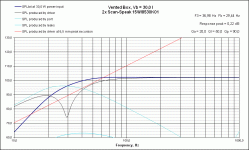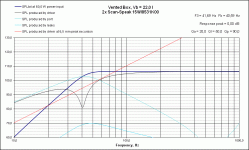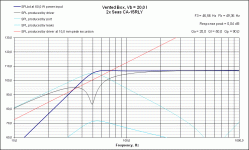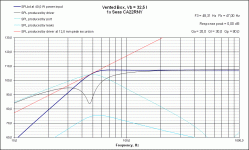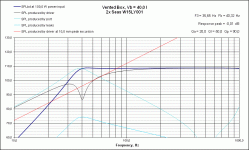First, apologies, I know there are heaps of threads with random posts singing the praises of low mms woofers and "fast bass" and just as many random posts saying mms doesn't matter as long as motor strength and amp power is there to "control" the woofer's cone. I've also read Troels' page about high-efficiency drivers.
All other things equal and with suitable amplification, will a low-efficient high mms woofer in a 0.707 alignment sound roughly the same as an efficient low mms woofer also in a 0.707 alignment? I'm not talking about golden ear listening or home cinema, just normal people with normal music in an average living room for stereo relaxation.
I will probably cross them around 250Hz or 300Hz and small size is the prize.
I'm just looking for one or two good solid opinions from trusted members before I dump a lot of cash on a quad of high mms, high xmax tiny woofers (Seas L16RNX3) for a dsp eq'd small sealed bass box. I'll probably used a steep slope Harsch crossover, as I assume this type of woofer will have trouble with mids.
I'm inexperienced enough that I might be missing something crucial and I really don't want to waste the cash only to be disappointed.
Thanks for your thoughts.
All other things equal and with suitable amplification, will a low-efficient high mms woofer in a 0.707 alignment sound roughly the same as an efficient low mms woofer also in a 0.707 alignment? I'm not talking about golden ear listening or home cinema, just normal people with normal music in an average living room for stereo relaxation.
I will probably cross them around 250Hz or 300Hz and small size is the prize.
I'm just looking for one or two good solid opinions from trusted members before I dump a lot of cash on a quad of high mms, high xmax tiny woofers (Seas L16RNX3) for a dsp eq'd small sealed bass box. I'll probably used a steep slope Harsch crossover, as I assume this type of woofer will have trouble with mids.
I'm inexperienced enough that I might be missing something crucial and I really don't want to waste the cash only to be disappointed.
Thanks for your thoughts.
For example, a lower efficient, high mms woofer in a 0.707 alignment in a 20 liter enclosure has lower F3 than a higher efficiency driver with the same SD, 0.707, 20 liter enclosure, but the higher efficient driver have higher sensitivity (and efficiency) upper in fequency. So it will not sound the same even if the alignment, SD, and enclosure size is the same.
Otherwise, the bass sound of L16 speakers are generally praised for their size (because of lower efficiency?), although I didn't heard these woofers yet.
Otherwise, the bass sound of L16 speakers are generally praised for their size (because of lower efficiency?), although I didn't heard these woofers yet.
Your Seas drivers are obviously good quality but I would have rethought the whole thing and get similarly good units for less money. Tang Band W6-1721, Peerless by Tymphany NE180W-08 for instance. You are DSP-ing everything so why bother with TS parameters. Design a steep subsonic filter and you probably won't have any Xmax concerns.
Thanks for the response.
Noted and understood. I'll use dsp to extend low frequency response. I understand limitations of doing this (max spl and power handling/xmas, etc.).
Noted and understood. I'll use dsp to extend low frequency response. I understand limitations of doing this (max spl and power handling/xmas, etc.).
"All other things equal and with suitable amplification, will a low-efficient high mms woofer in a 0.707 alignment sound roughly the same as an efficient low mms woofer also in a 0.707 alignment? "
I received from Seas 26RFX, H1411, Scan-Speak 26W8867, Seas 25F-EW (in closed boxes of 70-100 liters) 38-44 Hz resonance. But not a single 15-inch bass driver with a light diffuser, even theoretically, can get such low frequencies.
I received from Seas 26RFX, H1411, Scan-Speak 26W8867, Seas 25F-EW (in closed boxes of 70-100 liters) 38-44 Hz resonance. But not a single 15-inch bass driver with a light diffuser, even theoretically, can get such low frequencies.
Thanks for the input Lojzek and Datsun. The price is certainly right on those Tympany. I'm keen to keep the boxes as small as possible (~<20L).
So, any other (subjective is fine) thoughts on the sound of a high-mms woofer versus a low-mms woofer if they are both eq'd to the same frequency response and they are both crossed steeply before breakup?
So, any other (subjective is fine) thoughts on the sound of a high-mms woofer versus a low-mms woofer if they are both eq'd to the same frequency response and they are both crossed steeply before breakup?
The only way to accurately compare the two is to limit the test to the driver's effective Qts' upper mass corner [driver transitions from acceleration to mass controlled output] since all T/S theory peters out at this point. Once any mids - up BW is included it becomes an apples n' oranges comparison.
Qts' = Qts + any added series resistance [Rs]: HiFi Loudspeaker Design
Fhm = 2*Fs/Qts'
Qts' = Qts + any added series resistance [Rs]: HiFi Loudspeaker Design
Fhm = 2*Fs/Qts'
Thanks for the input Lojzek and Datsun. The price is certainly right on those Tympany. I'm keen to keep the boxes as small as possible (~<20L).
Tympany has a good price, but there is a saying about cheese and a mousetrap.))
For myself, for the future, I counted several small woofers in ported box of 20-40 liters, in Unibox:
Attachments
All other things equal and with suitable amplification, will a low-efficient high mms woofer in a 0.707 alignment sound roughly the same as an efficient low mms woofer also in a 0.707 alignment?
The problem with this kind of talk is that "all other things" are NEVER equal when you compare such different drivers. There are very different constructions used, and different goals, for a high-mms home subwoofer and a pro-audio low-mms high SPL driver. These include suspension type and linearity, cone thickness, motor design, etc. All of these will at some level influence the extension, distortion, response to thermal input from power, ability to have large excursion, etc.
When it comes down to it, while you can lump drivers into categories in various ways, each and every driver should be looked at as an individual that is different from all the others, and the differences will have some pluses and minuses in terms of meeting the goals of the loudspeaker project needs.
This above is especially true if you choose to use the driver in the higher part of its range, because the variability of the passband response close to the breakup region and ultimate rolloff, on and off axis, can be very different. When you only want to use the driver near resonance, e.g. for a subwoofer crossed low, then the upper passband extension and smoothness really doesn't matter.
In the end you will likely be best served by trying to match individual drivers to the particular application, and your budget constraints.
So, any other (subjective is fine) thoughts on the sound of a high-mms woofer versus a low-mms woofer if they are both eq'd to the same frequency response and they are both crossed steeply before breakup?
Wrong train of thought.))
From a woofer with a heavy diffuser in a small ported box, you can get 29-30 Hz (-3 dB). But its SPL from 1 watt will be in 84-85 dB and there will be difficulty with the selection of a powerful amplifier, from 100 W and above, and difficulty with pairing the tweeter.
The measured technical characteristics of a woofer with a heavy and light diffuser (namely high-speed ones) are almost the same for good woofers and lie far beyond the limits of human hearing. We hear only lower bass from heavy mms.
Qts' = Qts + any added series resistance [Rs]: HiFi Loudspeaker Design
Good to know that in my case Qts' = Qts.
Assuming that a difference of <0.002 is negligeable of course.
There's no magic or audible value to ".707" or to the concept with the seductive name of "critical damping". It is merely a computational convenience... which certainly is not a criterion that matters to me.
That's kind of like what CharlieLaub said more eloquently earlier. I think.
B.
That's kind of like what CharlieLaub said more eloquently earlier. I think.
B.
Last edited:
Good to know that in my case Qts' = Qts.
Assuming that a difference of <0.002 is negligeable of course.
I do believe 😀: DAMPING FACTOR DEBATE
GM
Bit OT but he did not give a satisfying reason as to why he splits the impedance into resistance and reactance and then proceeds to count the resistance twice.
Reminds me of a similar article in which the author dismissed DF based on the resistance of the connecting cable but uses resistances which are an order of magnitude higher than reality or he purposefully used fuse wire as cable.
Reminds me of a similar article in which the author dismissed DF based on the resistance of the connecting cable but uses resistances which are an order of magnitude higher than reality or he purposefully used fuse wire as cable.
Thanks for the conversation everyone. I've learned a lot and enjoyed the df link and especially CharlieLaub's post.
I do plan on using these far below their breakup frequency. In the end, for my application, I suppose of critical importance is the distortion behavior of the low mms driver when pushed hard with eq below its fs. As pointed out, this is driver independent and hard to generalize. Maybe easiest just to get high quality heavy mms drivers, feed them lots of power and let them loaf along...
I do plan on using these far below their breakup frequency. In the end, for my application, I suppose of critical importance is the distortion behavior of the low mms driver when pushed hard with eq below its fs. As pointed out, this is driver independent and hard to generalize. Maybe easiest just to get high quality heavy mms drivers, feed them lots of power and let them loaf along...
I do plan on using these far below their breakup frequency. In the end, for my application, I suppose of critical importance is the distortion behavior of the low mms driver when pushed hard with eq below its fs. As pointed out, this is driver independent and hard to generalize. Maybe easiest just to get high quality heavy mms drivers, feed them lots of power and let them loaf along...
Best not to confuse models with physical realities that are driver dependent (not independent).
Drivers distort according to their mechanical and magnetic/force motor construction and especially when that driver is pushed too far relative to its construction.
The driver in an enclosure distorts according to "too far" and not according to how you EQ or how the cone bumps about in a BR or TL box or where the mounted resonance(s) happen to fall.
But for a given "too far", some enclosures provide louder sound output by introducing resonances and/or feeding the emanations from the rear of the cone into the room too. Sadly, enclosures that traffic in these resonances and certain tricks also tend to sound lousy, large open baffles excepted.
Is that different from what your post meant to say?
B.
Last edited:
Best not to confuse models with physical realities.
Is that different from what your post meant to say?
B.
Not different at all. Of course my typo "independent" was meant to be "dependent". I understand that a driver will have frequency dependent distortion due to its own characteristics.
My original question was aimed at trying to decide on drivers based on mms, assuming I could get required bass extension and SPL within linear xmax and power handling,
Perhaps my questions have been poorly stated or somewhat misguided. Apologies. Regardless, everyone that responded has been helpful and rad!
DF, a bunch of nonsense. For any significant amplifier output impedance, we have a solution in designing conjugate networks to counteract the effect it's having on wildly changing loudspeaker impedance. Mr.Bagby and Mr.Waslo have provided excellent free software tools to find these solutions. End of story, problems solved.
- Status
- Not open for further replies.
- Home
- Loudspeakers
- Multi-Way
- 0.707 Qtc and Mms
